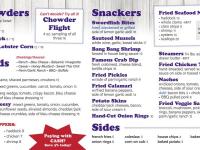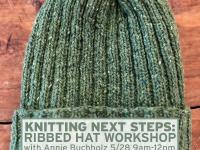Answers to cooking questions
The mail bag is over-flowing with questions so today’s column is all about filling you in on what everybody is buzzing about via What’s Cooking. I truly enjoy hearing from my readers so if you have a comment, question or suggestion, just drop me a note and include a business sized SASE if you’d like a personal response. Contact information is included every week at the end of the column. And now onto the questions and recipes:
Question from Julie: What are compound butters?
Answer: The French term is “beurre composés " and they are simply a mixture of butter and additional ingredients, often herbs, spices or aromatic liquids and are used to enhance flavor in various dishes.
You can easily prepare compound butters in your own kitchen by softening some butter and adding your choice of ingredients. I’m including my recipe for Roquefort-Shallot Compound Butter which can be kept in the fridge for about a week or in the freezer for up to 1 month. Served on pita crisps, crackers or French bread it makes a quick and tasty hors d’oeuvres, perfect to have on hand during the busy holiday season. It can be added to mashed potatoes or baked potatoes and is also the perfect add-on to grilled steaks, chicken or steamed veggies. Fresh herbs are the best choice when preparing compound butters.
Roquefort-Shallot compound butter
- 2/3 cup crumbled Roquefort cheese, at room temperature
- 1-1/2 tsp. Dijon mustard
- 2 Tbsp. minced shallot
- 1/2 cup (1 stick) butter, softened and cut into pieces
- 1 Tbsp. finely chopped fresh chives
- Generous pinch of freshly ground black pepper
Combine Roquefort, Dijon, and shallot in a mini-processor and process until a paste. Add the pieces of butter and process until smooth. Add the chives and pepper and use a couple of short pulses to just combine. Spoon the butter onto plastic wrap and shape into a log about 6 inches long. Roll up the plastic, forming the butter into a cylinder. Twist the ends tightly to press the butter into a compact log and refrigerate until firm. Yield: about 1 cup
Question from Roxanne: With all the holiday baking I’ll be doing soon, I know I’ll get caught without the right spice no matter how organized I try to be. Do you have one of your famous “cupboard door charts” of substitutions in an emergency?
Answer: You know me well, Roxanne! This is definitely on my pantry door and comes in very handy when you’re stuck.
Spice | Substitution |
| Allspice | cinnamon, cassia, dash of nutmeg, mace or cloves |
| Aniseed | fennel seed or anise extract |
| Cardamom | ginger |
| Chili powder | dash of bottled hot pepper sauce plus oregano and cumin |
| Cinnamon | nutmeg or allspice (use 1/4 the amount) |
| Cloves | cinnamon, nutmeg, or ginger |
| Cumin | chili powder |
| Ginger | allspice, cinnamon, mace or nutmeg |
| 1 teaspoon fresh chopped ginger | 1/4 teaspoon ground ginger |
| Mace | allspice, cinnamon, ginger or nutmeg |
| 1 tablespoon prepared mustard | 1 teaspoon ground mustard (in cooked dishes) |
| 1 tablespoon prepared mustard | 1/2 teaspoon ground mustard plus 2 teaspoons vinegar (in cold or uncooked dishes) |
| Nutmeg | cinnamon, ginger or mace |
| Saffron | dash of turmeric |
| 1 teaspoon apple pie spice | 3/4 teaspoon ground cinnamon plus 1/4 teaspoon ground nutmeg plus 1/2 teaspoon allspice |
| 1 teaspoon pumpkin pie spice | 1/2 teaspoon ground cinnamon plus 1/4 teaspoon ground ginger plus 1/8 teaspoon EACH ground cloves and ground nutmeg |
Question from Theresa: What is the difference between light and heavy cream? Are they interchangeable in recipes?
Answer: The real difference between all the different types of cream is all about the percentage of fat they contain:
- Half-and-Half: 12 percent fat
- Light Cream: 20 percent fat
- Light Whipping Cream: 30 percent fat
- Whipping Cream: 35 percent fat
- Heavy Cream and Heavy Whipping Cream: 38 percent fat
The amount of fat in proportion to the liquid determines the cream’s consistency as well as its versatility. The higher the fat content, the thicker the cream and the more ways you can use it. Creams with more fat will whip up better and also are less likely to curdle when added to soups. Lower fat creams are best used in beverages but can be cautiously used in soups.
If you don’t have the specific cream called for in a recipe, it’s always a pretty safe bet to select a cream with a higher fat content. For instance, if I had a recipe that called for light cream (20 percent fat) and what I had in the fridge was a choice of half and half (12 percent) or whipping cream (35 percent), I’d use the whipping cream.
Question From Ellen: I cannot seem to make a decent Hollandaise sauce to save my soul. Is there a substitute or do you have a recipe that even I can make successfully?
Answer: I’ve used this recipe for Hollandaise sauce for probably 35 years and it has yet to fail me. Give it a try!
No fail blender Hollandaise sauce
You can make this ahead of time and keep it warm in a thermal carafe or it can be gently reheated in the top of a double boiler set over hot (not boiling) water.
- 3 large, fresh egg yolks
- 2 Tbsp. fresh lemon juice
- 1/8 tsp. salt
- Dash cayenne pepper
- 2/3 cup hot melted butter (no substitutions)
Combine egg yolks, lemon juice, salt, and cayenne pepper in a blender. Cover and blend on high for 4 seconds. With blender running on high speed, very slowly pour hot melted butter into egg mixture, processing until sauce is smooth.
I’ve had the following recipe in my file for a long time and have never tried it. (Why go for the mock when you can easily have the real thing?) I’m including it in case you’d like to try it, Ellen.
Mock Hollandaise sauce
- 1/2 cup plain nonfat yogurt
- 1/4 cup reduced-calorie mayonnaise
- 2 tsp. lemon juice
- 1/8 tsp. ground red pepper
Combine all ingredients in a small pan, stirring until blended. Warm over very low heat. Yield: about: 3/4 cup with 19 calories per tablespoon.
Question from Margie: What is the latest on MSG?
Answer: MSG, (monosodium glutamate) is used in thousands of processed foods like soups, snack foods, frozen dinners and all kinds of fast foods and is basically a flavor enhancer. It is a form of the amino acid glutamate, a natural compound found in foods like tomatoes, cheese, and mushrooms. The FDA (Food & Drug Administration) says MSG is “generally recognized as safe” but that being said, it is known that it may trigger headaches and nausea in some people.
A study several years ago done by international scientists in Stuttgart, Germany, concluded that even when administered in abnormally high doses, MSG is “harmless for the whole population” including unborn babies and people with asthma. (Source: Gourmet Magazine 10/2007, Kelly Kingman, author).
“Kissing cousins” to MSG are additives like hydrolyzed soy protein, sodium casseinate and autolyzed yeast extract. So if you feel it best to avoid MSG for whatever reason, read the labels carefully.
Question from Sandy: Are Broccolini and broccoli rabe the same thing?
Answer: No they are not. Broccolini (also called baby broccoli) is a cross between broccoli and Chinese kale. The stalks are thin and tender (thus do not need peeling) and have a broad “tree” shaped head of buds. Broccolini has a slightly sweet-peppery flavor. Broccoli rabe (also called rapini) belongs to the cabbage and turnip family and has thin, leafy stalks with small broccoli-like buds. It has a very pungent flavor and is too bitter to be eaten raw – it is best steamed or braised.
Paula Anderson is a freelance journalist specializing in food, entertaining and nutrition. She writes for several newspapers, as well as Maine Food & Lifestyle Magazine. She divides her time between Scarborough and Big Pine Key, Fla., where she lives with her husband Peter and their kitty Mina. Correspondence can be addressed to her at the Boothbay Register, P.O. Box 357, Boothbay Harbor, ME 04538 or the Wiscasset Newspaper, P.O. Box 429, Wiscasset, ME 04578. You can also write to her directly via email at pander@maine.rr.com.
Event Date
Address
United States























